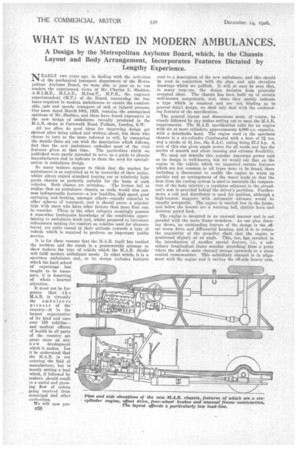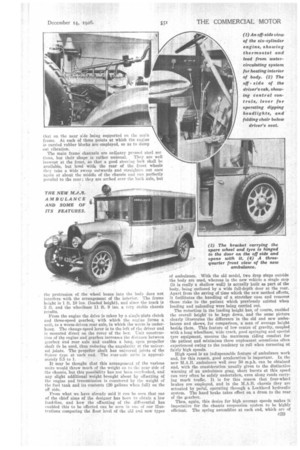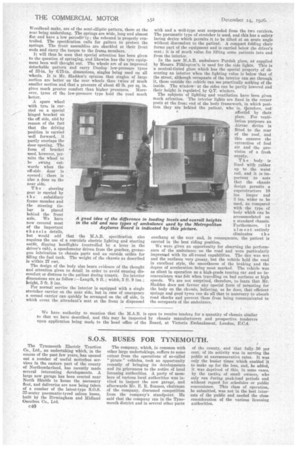WHAT IS WANTED IN MODERN AMBULANCES.
Page 62

Page 63

Page 64

If you've noticed an error in this article please click here to report it so we can fix it.
A Design by the Metropolitan Asylums Board, which, in the Chassis Layout and Body Arrangement, Incorporates Features Dictated by Lengthy Experience.
NEARLY two years ago, in dealing with the activities of the mechanical transport department of the Metropolitan Asylums Board, we were able to pass on to our readers the experienced views of Mr. Charles L. Sladden, A.M.I.M.E., M.I.A.E., M.Inst.T., M.P.E., the engineer superintendent (M.T.) of the Board, concerning the feetures required in modern ambulances to ensure the comfortable, safe and speedy transport of sick or injured persons. Our issue dated March 10th, 1925, contains the summarized opinions of Mr. Sladden, and these have found expression in the new design of ambulance recently produced in the M.A.B. shops at Carnwath Road, Fulham, London, S.W.
All too often du good ideas for improving design get shelved after being talked and written about, but those who choose to turn to the issue referred to will, by comparing the details there set out with the description which follows, find that the new ambulance embodies most -of the vital features given at that time. The particulars which we published were partly intended to serve as a guide to chassis manufacturers and to indicate to them the need for specialization in ambulance design.
So many makers appear to think that the market for ambulances is so restricted as to be unworthy of their notice, whilst others regard standard touring car or relatively light goods chassis as perfectly suitable for the basis of such vehicles. Both classes are mistaken. The former fail to realize that an ambulance chassis, as such would also possess indispensable features—a low load-line, high speed, good springing and braking, amongst others—equally essential in other spheres of transport, and it should prove a popular type with users who have other factors than mere first cost to consider. Those in the other category seemingly possess a somewhat inadequate knowledge of the conditions appertaining to ambulance work and, whilst prepared to introduce refinements making for comfort on vehicles used for pleasure travel, are quite casual in their attitude towards a type of vehicle which is required to perform an important public service.
It must not be forgotten that the
M.A.B. is virtually the ambulance pioneer of the country—it is the largest organization of its kind and uses over 150 vehicles—
and medical officers of health in all parts
of the country set great store on any n e w development which it makes. Let it be understood that the M.A.B. is not entering the field of manufacture, but is merely setting a lead which, if followed by makers, should result in a useful and growing flow of orders being received from municipal and other authorities.
We will now pro ceed to a description of the new ambulance, and this should be read in conjuetion with the plan and side elevation drawings which we publish. It will at once be seen that, in many regrets, the design deviates from generally accepted ideas. The chassis has been built up of certain well-known components, and, since they merely indicate a type which is required and are not binding as to general detall design, we shall only deal with the outstanding features of the specification.
The general layout and dimensions must, ofcourse, he closely followed by any maker setting out to meet the M.A.B.
requirements. The specification calls for an engine with six or more cylinders, approximately 4,000 c.c. capacity, with a detachable head. The engine used in the specimen chassis is a six-cylinder Continental with a bore of 31 ins. and a stroke of 4i ins., the R.A.C. rating being 27.3 h.p. A unit of this size gives ample power for all needs and has the merits of smooth and silent running and extreme flexibility.
We need not deacribe this popular American power unit as its design is well-known, but we would soy that on the engine in the vehicle which we inspected certain features which are not common to all types were to be found, these including a thermostat to enable the engine to warm up quickly and an arrangement of the water leads so that the heat from the cooling system is used to maintain the temperature of the body interior ; a regulator adjacent to the attendant's seat is provided behintithe driver's partition. Furthermore, a coil and distributor is used for ignition, although a high-tension magneto with automatic advance would be equally acceptable. The engine is carried low in the frame, and below the bonnet are a warning bell, electric horn and Autovac petrol feed.
The engine is mounted in an unusual manner and is not parallel with the main frame members. As our plan drawing shows, an outstanding feature of the design is the offset worm drive and differential housing, and it is to reduce the angularity of the propeller shaft that the engine is positioned slightly at an angle. This, too, has resulted in the introduction of another special feature, i.e., a subsidiary longitudinal frame member stretching from a point where the off-side main channel sweeps outwards to a stout central cross-member. This subsidiary channel is in alignment with the engine and it carries the off-side hearer arm, that on the near side being supported on the main frame. At each of three points at which the engine is carried rubber blocks are employed, so as to damp out vibration.
The main frame channels are ordinary pressed steel see tions, but their shape is rather unusual. They are well inswept at the front, so that a good steering lock shall be available, but level with the rear of the front wheels they take a 'tide sweep outwards and straighten out once again at about the middle of the chassis and run perfectly parallel to the rear; they are arched over the back axle, but
the protrusion of the wheel boxes into the body does not interfere with the arrangement of the interior. The frame height is 1 ft. 10 ins. (loaded height), and since the track is 5 ft. and the wheelbase 11 ft. 9 ins, a very stable chassis results.
From the engine the drive is taken by a single-plate clutch and three-speed gearbox, with which the engine forms a unit, to a worm-driven rear axle, in which the worm is underhung. The change-speed lever is to the left of the driver and is mounted direct on the cover of the box. Unit construelion of the engine and gearbox increases the distance between gearbox and rear axle and enables a long, open propeller shaft e0 be used, thus reducing the angularity at the universal joints. The propeller shaft has universal joints of the Spiter type at each end. The rear-axle ratio is approximately 5.5 to 1.
It may be thought that this arrangement of the various units would throw much of the weight on to the near side of the chassis, but this possibility has not been overlooked, and any slight additional weight brought about by offsetting of the engine and transraission is countered by the weight of the find tank and its contents (20 gallons when full) on the off side.
From what we have already said it can be seen that one of the chief aims of the designer has been to obtain a low load-line, and how the offsetting of the differential has enabled this to be effected can, be seen iii one of our illustrations comparing the floor level of the old and new types
of ambulance. With the old model, two drop steps outside the body are used, whereas in the new vehicle a single step (it is really a shallow well) is actually built as part of the body, being enclosed by a wide full-depth door at the rear. Apart from the saving of time which the new method effects, it facilitates the handling of a stretcher case and removes those risks to the patient which previously existed when loading and unloading were being carried out.
The reduction in the loading height has, of course, enabled the overall height to be kept dawn, and the same picture clearly illustrates the difference in the old and new ambulances and shows, for comparison, a man of average height beside them. This feature of low centre of gravity, coupled with a long wheelbase, wide track, good springing and special tyre equipment, ensures the maximum riding comfort for Use patient and minimises those unpleasant sensations often experienced owing to the tendency to roll when cornering at fairly high speeds.
High speed is an indispensable feature of ambulance work and, for this reason, good acceleration is important. In the new M.A.B. ambulance well over 50 m.p.h. can be obtained and, with the consideration usually given to the distinctive warning of an ambulance gong, short bursts at this speed can very often be safely undertaken, even along roads carrying much traffic. It is for this reason that four-wheel brakes are employed, and in the M.A.B. chassis they are actuated by pedal, operating through a Lockheed hydraulic System. The hand brake takes effect on a drum to the rear of the gearbox.
Then, again, this desire for high average speeds makes it imperative for the chassis suspension system to be highly efficient. The spring assemblies at each end, which are of c39 Woodhead make, are of the semi-elliptic pattern, those at the rear being underslung. The springs are wide, long and almost fiat and have a low periodiety ; the rebound is properly controlled. The mecifieation calls for gaiters to protect the springs. The front assemblies are shackled at their front ends and Carry the torque to the frame members.
It will thus be seen that special attention has been given to the question of springing, and likewise has the tyre equipment been well tholght out. The wheels are of an improved detachable pattern and carry Dunlop low-pressure tyres of 33-in. by 6.75-in, dimensions, singles being used on all wheels. It is Mr. Sladden's opinion that singles of large section are better on the rear wheels than twins of much smaller section and that a pressure of about 45 lb. per sq. in. gives much greater comfort than higher pressures. Moreover, tyres of the low-pressure type hold the road much better.
A spare wheel with tyre is carried on a special hinged bracket on the off side, and by reason of the fact that the driving position is carried well forward, it partly overlaps the door opening. The form of bracket used, however, permits the wheel to be swung outwards when the off-side door is opened ; there is also a door on the near side.
The steering gear is carried by
t h e subsidiary frame member and the steering tiebar is placed behind the front axle. We have now covered most of the important chassis details, but would add that the M.A.B. specification also requires the use of a complete electric lighting and starting outfit, dipping headlights (controlled by a lever in the driver's cab), a speedometer driven from the gearbox, greasegun lubrication to chassis parts and an outside orifice for filling the fuel tank. The weight of the chassis as described is within 27 cwt.
The design of the body also bears evidence of the thought and attention given to detail in order to avoid causing discomfort or distress to the patient during transit. Its interior dimensions are as follow :—Length, 8 ft.; width, 5 ft. 9 ins.; height, 5-ft. 8 ins.
For normal service the interior is equipped with a single stretcher carrier on the near side, but in case of emergency a second carrier can quickly be arranged on the off side, in which event the attendant's seat at the front is dispensed A good idea of the difference in In the old and new types of amb Asylums Board is ind with and a well-type seat suspended from the two carriers. The pneumatic type of stretcher is used, and this has a safety lacing device which permits it to be tilted at an acute angle without discomfort to the patient. A compact folding chair forms part of the equipment and is carried below the driver's seat ; it is of much value for lifting some patients into and from the interior.
In the new M.A.B. ambulance Purdah glass, as supplied by Messrs. Pilkington's, is used for the side lights. This is a neutral-tinted glass which hag the special property of obscuring an interior when the lighting value is below that of the street, although occupants of the interior can see through it, those outside the vehicle can see practically nothing of the inside. The windowat the sides can be partly lowered and their height is regulated by Q.T. winders.
The subjects of lighting and ventilation have been given much attention. The interior lights are fixed in the corner posts at the from. end of the body framework, in which position they are behind the patient, who is, therefore, not
affeettd by their glare. For ventilation purposes an Airvac device is fitted to the rear of the roof, and this ensures the extraction of foul air and the provision of a fresh supply.
The body is lined with rubber up to the waist rail, and it is important to note thet the chassis design permits a superstructure 18 ins, longer and 3 ins, wider to be used, as compared with the type of body which can be accommodated on
loading levels and overall heights a standard chassis. ulance used by the Metropolitan Furthermore, i t icated by this picture. a I m ost entirely
eliminates the overhang at the rear and, in consequence, the patient is carried in the best riding position.
We were given an opportunity for observing the performance of the ambulance on the road and were particularly impressed with its all-round capabilities. The day was wet and the surfaces very greasy, but the vehicle held the road in excellent style, the smoothness of the braking and the degree of acceleration being most marked. The vehicle was as silent in operation as a high-grade touring car and no inconvenience was felt when travelling on had surfaces at high speeds. We are not surprised, therefore, to learn that Mr. Sladden does not favour any special form of mounting for the body on the chessis, believing, as he does, that efficient springs and good tyres can do all that is necessary to absorb road shocks and prevent them from being communicated to the occupants of the ambulance.












































































































